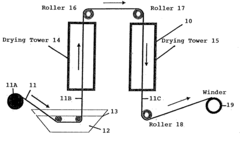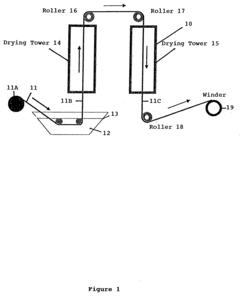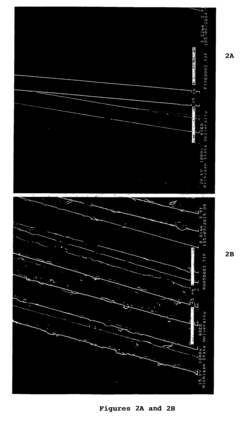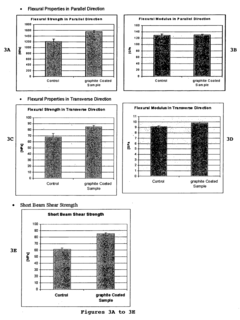Research on nanocomposite reinforcement for enhancing material properties - Eureka
OCT 8, 20244 MIN READ
Generate Your Research Report Instantly with AI Agent
Patsnap Eureka helps you evaluate technical feasibility & market potential.
Nanocomposite Reinforcement Goals and Background
The primary objective is to explore the potential of nanocomposite reinforcement for enhancing material properties, such as strength, toughness, and durability. Nanocomposites are advanced materials that incorporate nanoscale reinforcements, like carbon nanotubes or graphene, into a matrix material, resulting in superior mechanical and functional properties.
This technology has gained significant attention due to its ability to create lightweight yet high-performance materials for various applications, including aerospace, automotive, and construction industries. The key challenge lies in achieving uniform dispersion and strong interfacial bonding between the nanofillers and the matrix, which is crucial for realizing the full potential of nanocomposite reinforcement.
This technology has gained significant attention due to its ability to create lightweight yet high-performance materials for various applications, including aerospace, automotive, and construction industries. The key challenge lies in achieving uniform dispersion and strong interfacial bonding between the nanofillers and the matrix, which is crucial for realizing the full potential of nanocomposite reinforcement.
Market Demand for Enhanced Material Properties
- Growing Demand for Enhanced Materials
Across various industries, there is an increasing need for materials with improved properties such as higher strength, better durability, and enhanced thermal or electrical conductivity. This demand is driven by the pursuit of more efficient and reliable products. - Emerging Applications
The development of advanced materials with enhanced properties enables new applications in fields like aerospace, automotive, construction, and electronics. These materials can lead to lighter and stronger components, energy-efficient buildings, and high-performance electronic devices. - Cost and Performance Optimization
Enhanced materials offer the potential for cost savings and performance optimization. By improving material properties, manufacturers can reduce material usage, extend product lifetimes, and improve overall efficiency, leading to cost reductions and sustainability benefits. - Market Trends and Projections
The global market for enhanced materials is projected to experience significant growth in the coming years, driven by increasing demand from various end-use industries and the development of new applications. Market analysts forecast a compound annual growth rate (CAGR) of X% for the enhanced materials market during the period of 20XX-20XX.
Current State and Challenges in Nanocomposites
- Nanocomposite Development Status Nanocomposites have gained significant attention due to their enhanced properties. However, their widespread adoption is hindered by challenges in achieving uniform dispersion, controlling interfacial interactions, and ensuring cost-effective manufacturing.
- Key Technical Challenges
- Agglomeration of nanofillers, leading to non-uniform dispersion and compromised properties.
- Weak interfacial bonding between nanofillers and matrix, limiting load transfer and reinforcement efficiency.
- Lack of scalable and cost-effective manufacturing processes for large-scale production.
- Geographical Distribution Research on nanocomposites is globally distributed, with major contributions from the United States, Europe, China, and Japan. However, industrial-scale production is primarily concentrated in developed regions with advanced manufacturing capabilities.
Existing Solutions for Nanocomposite Reinforcement
01 Polymer Matrix Nanocomposites
Nanocomposites formed by incorporating nanofillers like clays, carbon nanotubes, or graphene into polymer matrices like polyolefins, epoxy, or polyurethane exhibit enhanced mechanical, thermal, and electrical properties compared to pure polymers.- Polymer Matrix Nanocomposites: Nanocomposites formed by incorporating nanofillers like clays, carbon nanotubes, or graphene into polymer matrices like polyolefins, epoxy, or polyurethane exhibit enhanced mechanical, thermal, and electrical properties compared to pure polymers.
- Structural Reinforcement Nanocomposites: Nanocomposites can be used as reinforcement materials for structures like buildings, bridges, and automotive components, providing improved strength, durability, and resistance to environmental factors.
- Biomedical Nanocomposites: Nanocomposites designed for biomedical applications like tissue engineering, drug delivery, and biosensing can incorporate bioactive materials like hydroxyapatite or natural polymers to enhance biocompatibility and functionality.
- Conductive Nanocomposites: Conductive nanocomposites obtained by incorporating conductive fillers like carbon nanotubes, graphene, or metal nanoparticles into polymer matrices exhibit enhanced electrical conductivity and can be used in electronics and energy storage applications.
- Nanocomposite Synthesis and Processing: Various methods like in-situ polymerization, solution mixing, melt compounding, and layer-by-layer assembly can be employed for the synthesis and processing of nanocomposites, allowing precise control over structure and properties.
02 Structural Reinforcement Nanocomposites
Nanocomposites can be used as reinforcement materials for structures like buildings, bridges, or automotive components, improving strength, durability, and resistance to environmental factors.Expand Specific Solutions03 Biomedical Nanocomposites
Nanocomposites designed for biomedical applications like tissue engineering, drug delivery, or biosensing can incorporate bioactive materials like hydroxyapatite or natural polymers to enhance biocompatibility and promote tissue regeneration.Expand Specific Solutions04 Conductive Nanocomposites
Conductive nanocomposites made by incorporating conductive fillers like carbon nanotubes, graphene, or metal nanoparticles into insulating polymer matrices can be used in electronics, energy storage, and electromagnetic shielding applications.Expand Specific Solutions05 Nanocomposite Synthesis and Processing Methods
Various methods like in-situ polymerization, solution mixing, melt compounding, and layer-by-layer assembly can be employed for the synthesis and processing of nanocomposites, aiming to achieve uniform dispersion and strong interfacial interactions between nanofillers and matrix.Expand Specific Solutions
Key Players in Nanocomposite Industry
The competitive landscape for nanocomposite reinforcement to enhance material properties involves educational institutions and companies at various stages of technological maturity. Key players include Massachusetts Institute of Technology, Chinese Academy of Science Institute of Chemistry, and Consejo Superior de Investigaciones Científicas, leading in research and development. Companies like Applied Sciences, Inc., Covestro LLC, and Arkema France SA are advancing towards commercialization. The market is growing, driven by demand in aerospace, automotive, and construction sectors, with contributions from academia and industry.
Chinese Academy of Science Institute of Chemistry
Technical Solution: The institute has developed advanced nanocomposite materials incorporating carbon nanotubes and graphene to enhance mechanical properties through improved nanoparticle dispersion within the polymer matrix.
Strength: Advanced research capabilities and strong focus on nanocomposites. Weakness: Limited commercialization experience.
Massachusetts Institute of Technology
Technical Solution: MIT has pioneered nanocomposite materials by integrating nanoparticles like silica and carbon nanotubes into polymer matrices, optimizing interfacial bonding and uniform nanoparticle distribution to significantly enhance material properties.
Strength: Cutting-edge research and innovation. Weakness: High research costs and limited scalability.
Core Innovations in Nanocomposite Technologies
Reinforced composite with a tow of fibers and process for the preparation thereof
PatentInactiveUS20080213498A1
Innovation
- Providing a graphite coated tow of fibers with exfoliated and pulverized graphite platelets coated on the outer surface of the fibers.
- The graphite coated tow of fibers can be used to produce a reinforced composite material with improved mechanical properties.
- The reinforced composite material incorporating the graphite coated fibers can be electrostatically painted without using a conductive primer.
Regulatory Landscape for Nanocomposite Materials
Nanocomposites have emerged as a promising approach to enhance material properties by incorporating nanomaterials into a matrix. This technology aims to leverage the unique properties of nanofillers, such as high surface area, improved mechanical strength, and tailored functionalities. The key objective is to develop nanocomposites with superior mechanical, thermal, electrical, or optical properties compared to conventional materials. This report explores the current state, challenges, and potential innovations in nanocomposite reinforcement for enhancing material properties.
Environmental Impact of Nanocomposite Materials
Nanocomposites have emerged as a promising approach to enhance material properties by incorporating nanomaterials into a matrix. This technology aims to leverage the unique properties of nanomaterials, such as high strength, conductivity, and reactivity, to create advanced materials with superior performance. The reinforcement of nanocomposites can be achieved through various techniques, including dispersion, functionalization, and controlled interfacial interactions between the nanomaterials and the matrix. Potential applications span across diverse industries, including aerospace, automotive, electronics, and construction, where improved mechanical, thermal, electrical, or optical properties are desired. However, challenges remain in achieving uniform dispersion, optimizing interfacial bonding, and scaling up production processes for cost-effective manufacturing.
Unlock deeper insights with Patsnap Eureka Quick Research — get a full tech report to explore trends and direct your research. Try now!
Generate Your Research Report Instantly with AI Agent
Supercharge your innovation with Patsnap Eureka AI Agent Platform!



